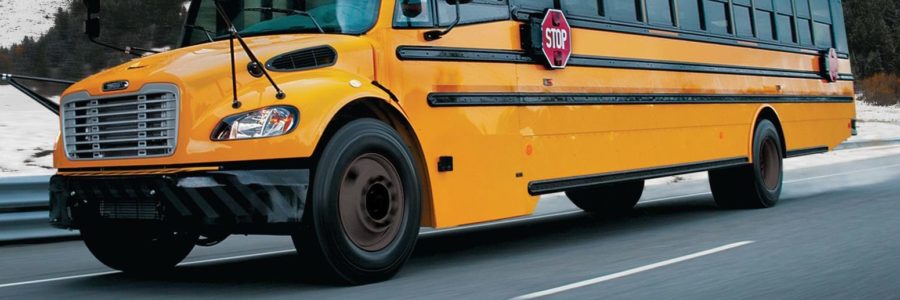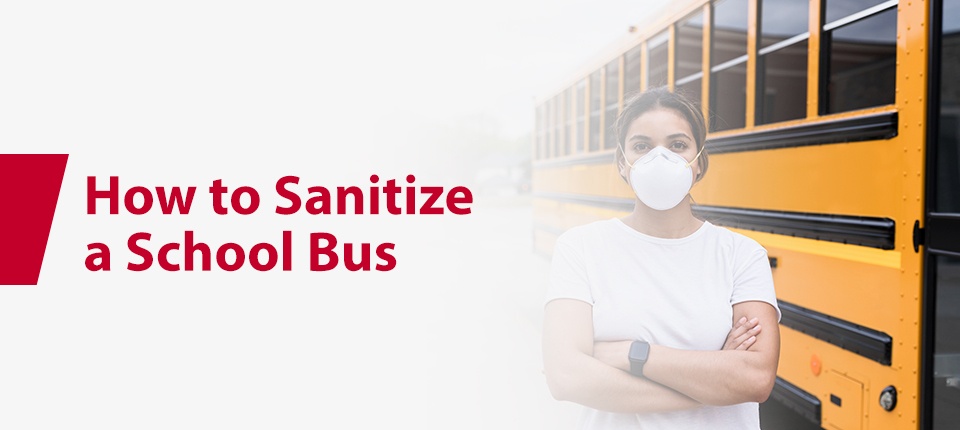

School buses can hold dozens of students or other passengers every day. With them, they bring jackets, book bags — and germs. Buses can be havens for bacteria and viruses, as they can easily spread in the enclosed space. For everyone’s safety and well-being, it’s essential to sanitize school buses as often as possible using proper methods.
You’ll need to have the right supplies to promote a clean and hygienic environment. You’ll also need to follow specific steps and guidelines as you sanitize. As an added precaution, you might choose to install specialized bus protective equipment. For the best results, use these bus sanitation tips.
Before you can get down to sanitizing, you’ll have to gather all the equipment you’ll need. A lack of proper supplies can pose a safety risk during and after disinfecting. The right supplies will ensure protection during the process and promote a thorough result. Some materials are vital for effective sterilization. First things first, check off everything on this list.
PPE limits your exposure to germs and disinfectant chemicals as you sanitize. The Centers for Disease Control explains correct PPE use, including gloves and face masks. Be sure to use all the necessary PPE when decontaminating your school buses. Anytime you use powerful disinfectant chemicals, you should use disposable gloves. Both students and drivers need adequate PPE when sanitizing.
Before and after disinfecting your school bus, you should use hand sanitizer. If you transport small children, make sure you store this product out of their reach. Ingesting hand sanitizer can be dangerous, and young, curious kids love to taste-test new things. You can read more about the safe use of hand sanitizer.
Disposable wipes will help you spot-clean dirt or spills before you sanitize. Keep some in a convenient place on your school buses. It’s always a good idea to have some disposable wipes on hand when transporting children. These are sure to come in handy from time to time.
To kill the germs on surfaces, you’ll need to use an alcohol-based cleaner. Refer to your safety data sheet when choosing the right cleaning solution. Never mix different chemicals, as that can pose a safety risk. Be thorough when applying your cleaning solutions, and allow them adequate time to set and dry before any passengers board. Follow all safety instructions included with the cleaner.
It’s smart to install temporary, transparent barriers between passengers. These help separate passengers to keep germs contained. They allow for easy, quick removal, so you can sanitize and clean them often. A soft shield provides extra protection for drivers or high-risk passengers. Depending on your state and school district, you can install them in as many places as needed between seats.
Sanitizing involves dangerous chemicals and potential exposure to germs. For those reasons, you need to be cautious and deliberate about your processes. There are right and wrong ways to disinfect, so be sure to follow all guidelines and procedures. If you’re wondering how to decontaminate your bus, keep these pointers in mind:
Keep reading to learn how to implement these tips. Proper sanitization procedures will ensure the safety of everyone who sets foot on a bus, whether they’re drivers or passengers.
Once you’ve gathered all the necessary supplies, you can get ready to sanitize. Thoroughly wash your hands, then apply your gloves and other PPE. When you’re suited up, start by spot-cleaning any visible dirt or mess. Sweep, mop or vacuum as needed. Pick up trash, wipe away any spills and clean the windows. Remember, always clean before you disinfect. Cleaning refers to removing visible dirt, while sterilizing kills invisible germs.
While you want to clean and sanitize as many areas as possible, it’s a good idea to focus your efforts where they’ll have the most impact. As you clean and sterilize, focus on high-touch areas first. These could include door handles, seat belts, handrails, the steering wheel, and other surfaces passengers and drivers tend to contact often. The higher-touch something is, the more likely it is to harbor germs. You’ll also want to wipe down heating and air conditioning vents, since some germs are airborne.
Before and after you wipe down any surfaces, always wash your hands. This step is essential for your protection, to kill any germs that may cling to you as you clean. It’s best to use warm soap and water, but hand sanitizer works as well.
An air sanitizing system makes the task of disinfecting much easier. It works much like a sprinkler, dispelling disinfectant through the vehicle’s entire interior. Though manual cleaning is still necessary, this provides an effective way to cover most surfaces with disinfectant. It’s sure to save you time and effort. You can set variables and controls and operate from a distance using Bluetooth.
Air filters are necessary for any indoor space. They help remove microorganisms and allergens circulating in the air to promote comfort and safety. Several options are on the market, but UV-C air filters are among the most effective choices. They alter the DNA of passing bacteria and viruses. Doing so destroys their ability to perform vital functions like reproduction, which makes them a non-threat. UV-C filters offer a safe and powerful way to remove airborne germs from your bus.
While manual cleaning and sanitizing are always necessary, the right protective equipment can make your bus a much safer environment. Besides cleaning solutions and disposal PPE, you might choose to install soft shields, air sanitizing systems and air filter systems. Each piece of equipment adds a new layer of protection. Soft shields help contain germs for minimized spread, and air sanitizers provide a safe, hands-free way to cover surfaces with disinfectant. Air filters remove germs from shared indoor air.
Add high-quality equipment to your buses to limit bacterial, viral and allergen spread. Keep your drivers and passengers comfortable and safe from the spread of germs. To learn more about protective equipment for buses, contact Rohrer Bus today by filling out our convenient online form or calling 717-546-9319.
We’re looking for dependable people to join us in Driving the Future Forward! Explore Open Positions